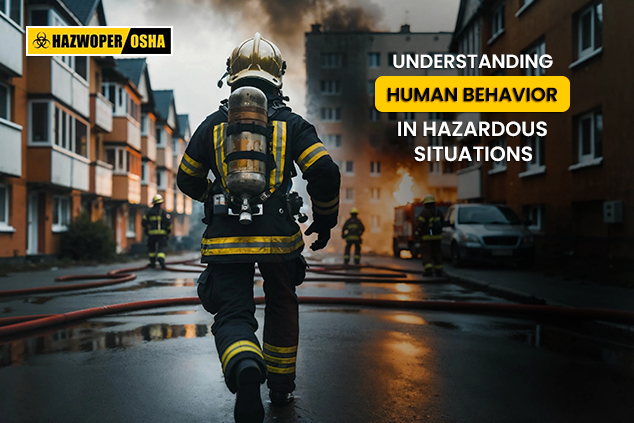Understanding Human Behavior in Hazardous Situations

Human behavior plays a critical role in how individuals respond to hazardous situations. Whether it's a workplace accident, a natural disaster, or a chemical spill, understanding why people react the way they do can help improve safety protocols and mitigate risks. In this article, we'll explore the psychology behind human behavior in hazardous situations and provide practical tips on what individuals can do to stay safe.
To raise safety awareness and mitigate risks, it is pertinent to understand human behavior in hazardous situations. Understanding how people typically respond in such circumstances can help individuals become more aware of their reactions and better prepare themselves. It allows the identification of potential vulnerabilities in safety protocols, leading to improvements that can minimize risks.
Moreover, conversations about human behavior aid in emergency preparedness by helping develop more effective response plans. Tailoring training programs to address human behavior in hazardous situations can better prepare employees for real-life scenarios, ultimately improving overall safety. Moreover, insights gained from understanding human behavior can inform the development of more effective communication strategies for conveying safety information and instructions during emergencies.
The Fight or Flight Response
In a hazardous situation, the fight or flight response is an instinct that occurs in response to a perceived threat. It prepares the body to either confront the threat or flee from it. To respond effectively, it's critical to assess the situation calmly and determine the best course of action. If evacuation is safe, follow emergency procedures and evacuate the area immediately. In case evacuation is not possible, seek shelter in a nearby location that is safe and await further instructions. Stay informed by listening to updates from emergency responders and follow any instructions given. On top of it, try and assist others who may need help evacuating or finding shelter. Remaining calm is essential, as panic can hinder your ability to make safe decisions. Remember, your safety and the safety of others are the top priorities in any hazardous situation.
Managing Fear and Anxiety
- Practice deep and slow breathing to calm the body and mind.
- Remind yourself to stay focused on the present moment and the necessary actions.
- Use positive affirmations to reassure yourself and maintain a clear mindset.
- Reach out to colleagues or emergency responders for support if feeling overwhelmed.
- Adhere to established safety protocols and procedures to regain a sense of control.
- Keep yourself updated on the situation by listening to updates from authorities or emergency responders.
- Acknowledge and address your emotions calmly and rationally to maintain clarity in decision-making.
Perception and Experience
Perception and past experiences play a significant role in how individuals respond to hazardous situations. Those who have received safety training and have prior experience dealing with similar scenarios may be more confident and better equipped to handle the current situation. Their training and experience can provide valuable insights into recognizing and managing risks effectively. However, it's pertinent not to become complacent. Even experienced individuals should stay vigilant and follow safety protocols to ensure their and the safety of others. It's also important to be aware of your surroundings and any changes in the situation that may require a different response.
Effective Communication
Effective communication is vital during hazardous situations. It entails accurate, clear, and concise dissemination of information in a timely manner. If you are in a position to communicate with others, it is essential to do so clearly and calmly. Not only this, but also utilize multiple communication channels, such as verbal, written, and visual aids, to reach all individuals effectively.
Consistent messaging across various channels helps prevent misunderstandings and ensures that everyone is aware of the current situation and can take the necessary steps to stay safe.
When you receive information, listen carefully and follow instructions promptly. Pay attention to any changes in the situation and be prepared to adjust your actions accordingly. Effective communication is a two-way process that includes listening actively and responding appropriately.
Training and Preparedness
Training and preparedness are pivotal to staying safe in hazardous situations. It is critical that you're familiar with emergency procedures and know how to use any safety equipment available to you. Regular training and drills can help reinforce these skills and equip you to respond effectively in an emergency.
Our courses are designed to help you prepare for such situations. Whether you're looking to refresh your knowledge or learn new skills, our courses provide comprehensive training on emergency procedures, safety protocols, and the use of safety equipment. By enrolling in our training courses, you will learn to handle hazardous situations safely and effectively, protecting yourself and those around you.
Conclusion
Understanding human behavior in hazardous situations is crucial for staying safe. By recognizing the fight or flight response, managing fear and anxiety, understanding the influence of perception and experience, practicing effective communication, and staying trained and prepared, individuals can improve safety outcomes and protect themselves and others in hazardous situations.
Conscious of common human reactions, such as the tendency to follow the crowd or to underestimate risks, can help individuals make more informed decisions in emergencies. It's also important to consider the impact of stress and fatigue on decision-making during emergency situations. To curb this, one needs to prioritize self-care. By understanding human behavior during emergencies, individuals can enhance their safety and the safety of those around them.

 EN |
EN |  ES
ES
































































































































